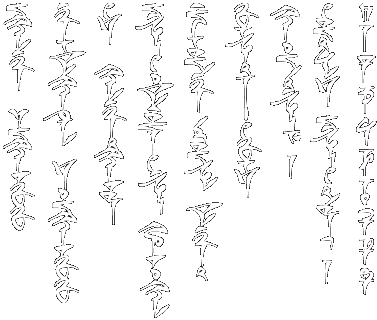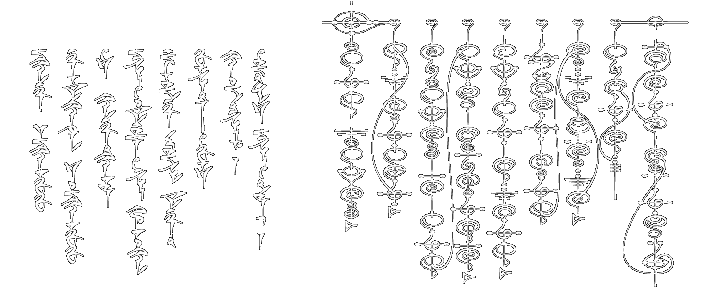| Very few non-Vulcans are familiar with Vulcan handwriting. It is one of the first things taught to Vulcan children in their formal education, but other than the context of private contemplation, there is very little need to write by hand in modern Vulcan society.This example shows the two sentences “Stonn killed the le-matya with an antler that he found in the sand after the animal bit his kneecap. It was mid-afternoon.” It is then followed by the numerals 0~9. | I’nam-tor el’ru-kitaun maafainik goh na’ri-vuhlkansu maut-zamik. Nam-tor wuhkuh t’wuhr-ong ik saven-tor na’kanu vuhlkansu svi’hotor-ek’saven, ki kula na’ong t’sha’tapan, nam-tor maut-pi’bolaya ik kitau k’el’ru svi’iyi-shila’es t’vuhlkantra. Sagluvau nash li-fal dah-zhit-bal °Stal Stonn le-matya k’stonn ik tal-tor svi’mazhiv po’ta zeshal aushfa mal-nef-hinek t’sa-veh. Ish-wak svi-aru.° Po’ish palikau feim t’su’us ik s’0 abi’9. |
| It is very easy to see that this type of script bears no design relationship to ceremonial calligraphy. The same text appears in both formats below. They are from two completely different traditions. However, they share the tendency to be more often written vertically than horizontally. | Veling kup gla-tor veh ta ri ma nash kitaun-ves patanafaya-tersaya na’vanu-tanaf-kitaun. Ne’la saudau ka-kitaya fna’on t’yidor. Sasarlah s’dah-natya-ba’tak — hemshin vuhrgwau galat-venek ik pukitau weh-k’ashiv abuling do yuting. |
| The handwriting glyphs originate from the same traditional system that is sometimes represented on ancient Vulcan dice. But, there is no obvious one to one correlation visually between the two due to the fact that the letters have undergone extensive simplification over time. Stylistically, these letterforms are somewhat similar to the standard script, but do not mimic them directly. | Tveshulau zhiyeh t’el’ru-kitaun s’ka-ba-torektra ik ein-wak saudau svi’ma’os-zhagra-muk. Ki ri nam-tor pa’shi-pashif spo’glan-ka’es sva’dahkuh fna’kla-min ik ki-veshtal velin’es lo’uk mes’wak. Fupa s’kuhz nash zhiyeh plo-kahkwa ka’a’gotavlu-zukitan, ki ri va’amau kharing. |
| This type of handwriting also appears horizontally and unlike traditional calligraphy does not rotate its glyphs when that occurs. They are simply positioned side by side with spaces between words. However, there are two major stylistic variations regarding the method of writing the vowels. In the most common style, vowels are written as superscript diacritics above the consonants. This is similar to some Indic abugida systems on Terra. The main reason for this is spacial efficiency. Compare the horizontal text above and below this paragraph to see that the preceding style requires less horizontal space than the one that follows. In the independent vowel model, each vocalic glyph rides on a ‘carrier’ in a similar fashion to Korean syllables that begin with a silent ‘ng’. | Isha yuting saudau nash el’ru-kitaun-ves heh rika’a’vanu-tanaf-zukitan ri da-tor zhiyeh ish-wak paresh-tor doming. Veling pushul-tor vla be’vla spo’ta ret svi’kanok-zhit. Ki, vah na’tikap t’ikatu’azun-kitaun nam-tor mortuyik-renyut-vuhnaya dah. Vah na’dan-tsuk-renyut kitau n’ikatu-azun abru’ikastarzun u’abu-salashar-ulidar kahkwaing ein-kitaun-torektra u’abugida t’India t’Terra. Nel-utvau na’nash skurin ret-yeht-urgam’es. Navathau n’yuti-zukitaun weh-abuk na’veh weh-nuk ik ne’nash nahptra na’lof pakashogau n’ta ya’bolau wuhr-renyut ten t’yuti-ret do veh ik zahal-tor. Vah na’rev t’tikop-ikatu-azun fau-tor kanok-zhiyeh t’ikatu-azun fi’leshek vah tikap ik kahkwa zhit-shaya t’Hanguk-gen ik palikau k’ngo ralash-famik. |
| If having two different systems for horizontal handwriting seems illogical, quite the opposite is true. Vulcan children are taught that logic is not merely some universal correct answer to a question, but rather the concept or discipline of processing the information at hand to make an optimally informed choice. When writing horizontally one must choose the style which is most logical for the immediate task. One must choose overall efficiency over clean, linear simplicity. The correct answer lies only in the mind of the maker of the choice.
A more complete introduction to Vulcan handwriting with all letters and conventions is available HERE. |
Kuv ma dahr-natya-torektra na’yuti-el’ru-kitaun sauyau riozhikaik, mesyuting wa’nam-tor yeht’es. Saven-tor n’kan ta ri nam-tor ozhika veling ein-yeht-kilkaya ek’ovsotik na’deshker, ki keing rata il tafar ik tapan-tor n’ro’fori la’ka-yehat na’lof dvel-tor vah ki’puro’fah dan-roming. Ish-wak ik kitau yuting vun-dvel-tor veh renyut ik dan-ozhikaik na’iwi-pi-zupkes. Tal-tor veh yeht-kilkaya goh svi’sha-kashek t’veh ik dvel-tor.
LA i’nam-tor whet-ovsot-ragtaya na’el’ru-kitaun-torektra ik vinam-tor ek’nuhm heh ek’skurin. |






I see the prefix n’- on a lot of words but can’t figure out what it stands for. I thought maybe it was short for na’- and maybe used in front of vowel sounds? But this doesn’t seem right from looking at some of the words with n’- on them. Can you enlighten me? I’m trying to learn some Vulcan but there aren’t many websites that concentrate on how to speak it as opposed to vocabulary.
oDzheimz,
I should really write up an article on the “dialect” here. This is an excellent question and shows that you really are studying and UNDERSTANDING the language. The prefix ‹n’› is theoretically linguistically evolved from ‹na’›, but it is not just a shortening of ‹na’› and it does not mean the same thing. It exists to make the language a tad bit more ‘logical’. Since Golic Vulcan is ‘pro-drop’ (meaning it allows or encourages the dropping of pronouns when they might be considered redundant) it is very easy to end up with a sentence in which it is not precisely clear who/what the subject of the sentence it. For example. “Stal Stonn le-matya.”. Stonn killed the le-matya. is unambiguous. The verb is there (first, stal), the subject is there (second, Stonn), and the object is there (third, le-matya). This is normal Modern Golic Vulcan word order (VSO). It is also possible to say “Pustal le-matya (bai’Stonn)”. The le-matya was killed (by Stonn). This is possible due to the existence of a specific verb in the passive voice for “to be killed” (pustau). However, it seems that adding the prefix ‹pu.› productively to just any verb is not done. Certain verbs have a ‘passive voice’ form, but not all of them. So, this is where the mysterious ‹n’› comes into play in the language you see written here at Korsaya.org. It marks the OBJECT of the verb when the subject has been dropped.
A: Ki’ro’fah fan-veh tu pa’Stonn, ha. (Lit: (Perfective)’inform anyone you about’Stonn, yes?) ››› Has anyone told you about Stonn?
B: Ri. Ra. (Lit: No. What?)
A: Stal n’le-matya. (Lit: killed (obj.)’le-matya) ››› (He) killed a le-matya.
If this sentence were to be rendered without the ‹n’›—because the language is pro-drop—it could mean “A le-matya killed (him)”.
This prefix ‹n’› would also come in very handy for the first Question:
A: Ki’ro’fah n’du pa’Stonn, ha. (Lit: (Perfective)’inform (obj.)’you about’Stonn, yes?) ››› Has anyone told you about Stonn?
It’s shorter and still means the same thing.
This object-marking ‹n’› prefix is pronounced one of 3 ways depending on what it bumps into:
1) just n (n’odu ››› /nodu/, n’yon ››› /nyon/)
2) with a schwa [ə] (n’vel ››› /nəvel/)
3) as a long or double nn (n’nash-veh ››› /nnash-veh/)
You should just think of it as a dialectal variation. It is NOT used when the subject is stated overtly in the sentence. Marking the object is never obligatory (even when the subject is dropped). There are scenarios in which the nature of the conversation clarifies the object unambiguously thereby negating the value of ‹n’›.
Rok-tor ta gol-tor n’du. (Lit: Hope that help (obj.)’you). ››› I hope that I am helping you.
For my 53rd Birthday I wish to have a the Vulcan saying ‘live long and prosper’ tattooed on my shoulder. Star Trek has lasted longer than both my marriages and as I am now old I dont care what a tatto would look like when I am old!
I very much want to have this phrase in ceremonial vulcan as this script looks beautifully musical.
I sincerely hope you can help me with this request.
Kim Mawdsley
Brisbane
Australia.
oKim,
Congratulations on 53 years of life on earth!
I’d be happy to help, but I’d prefer to respond to you via a reply to your having sent a mail to the address on the Contact • Mestau page. Please go find that address and ping me there directly. I will need to send you a file enclosure with the artwork in it and I prefer to do that via regular e-mail addresses.
s’Briht’uhn
I am looking to “The needs of the many outweigh the needs of the few…or the one” in Vulcan script. Can you help with this?
I am exceedingly behind on actually providing this kind of help/artwork, but the first formal step would be for you to write to me at skladan {at} korsaya {dot} org.